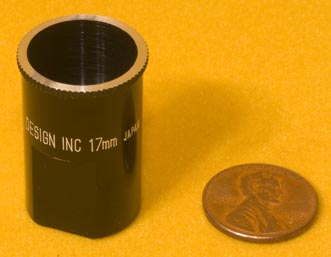
NOTE: All shutters and barrels with mounting flanges unless noted. Lenscaps provided unless I cannot find caps in my 200+ inventory. All Copal shutters are synchronized. All come with a 10 day money back guarantee. Some macro and micro lenses are listed here, but most are to be found on my copy camera list. Most enlarging lenses are to be found on one of my darkroom lists. All barrel mount lenses have diaphragms unless noted. If a lens is not listed as being coated or multicoated, then it is uncoated. Telephoto lenses are listed as such and require only about 3/5 the focal length to focus at infinity, but they do not have as wide an image circle as normal lenses. Portrait lenses are individual; each is described. Some shutters, lens mounts, lens cases and some other lens accessories are listed among the lenses. I have many lensboards in stock and will gladly sell you a lensboard and mount the lens for you. Books about lenses are found on my book web page. Shutters and lens flanges are found on my view camera lens shutters web page.
17mm Micro Design Japanese lens from microfiche reader, barrel, no diaphragm, coated, high resolution @ high magnification, great macro or micro lens or small pocket magnifier, no flange or mounting system (can be set into neatly bored hole in lensboard--I'll do it for you for the cost of the lensboard plus $50 for boring the hole and mounting the lens), $50
24mm, 25mm, 35mm, 42mm Leitz Summar lenses, 50mm Leitz Milar lens, related Leitz Aristophot equipment, Linhof Luminar adapters, RMS mount adapters, Leica screw mount adapters, and lots more related equipment on my Copy Cameras web page.
32mm f4.5 to F22 Zeiss Micro Tessar, in barrel without flange, tiny, bubbles in glass, dirt specks in glass, probably still perfroms pretty well, if you want to see some photos made with a Micro Tessar, go to my STEREO page, $50
40mm F4 Schneider Componon, coated, in barrel w/o diaphragm or mounting flange. Lens has groove around waist. Easiest way to mount it is with a universal diaphram lensholder. Macro lens. Ex+, $40. Universal diaphragm lensholders are to be found on my VIEW CAMERA LENS ACCESSORIES page.
53mm F4 Technika Super Angulon lens, coated, Linhof Compur #0 shutter, for 6X9cm, designed to be a direct competitor to the 53mm F4.5 Zeiss Biogon, performs at least as well in my opinion, rare, boxed, Mint, $1000. This lens was sold. I have another, not in the box, but with a Sinar Handy type camera. I am willing to sell that lens without the camera for $500. See my SINAR CAMERAS web page for that camera and lens.
58mm F5.6 Super Angulon XL, 115 degrees coverage, multicoated, Synchro Copal #0. Great lens! Covers 4X5". Mint. $800
72mm F6.3 Wollensak Raptar, coated, barrel, fixed aperture, built-in mounting ring. This was probably designed as a flat field macro copy or projection lens. It does a great job of magnifying the pixels on my computer monitor. Pretty clean glass. It may cover some larger formats at higher magnifications; 35mm is a safe bet at just about any magnification. $20.
75mm F3.5 German Anastigmat. Coated. PC sync terminal. Prontor Press shutter. Shutter works intermittantly--needs repair. $20
75mm F4.5 Tominon: see my Copy Cameras web page.
75mm F6.8 Rodenstock Grandagon, multicoated, Copal, 100 degree coverage wideangle lens, Mint, $400
75mm F8 Fujinon SW, coated, Copal, 106 degree coverage wideangle lens, Mint, $500. Plaubel Peco Jr. lensboard not included, but available separately.
75mm F48 Goerz Hypergon. This lens has been sold, but while I had it I photographed it for your enlightenment. Additional photos and info about Hypergons.
90mm F8 Fujinon SW, multicoated, 106 degree coverage wideangle lens, Mint, $500. Plaubel Peco Jr. lensboard not included, but available separately. These lenses are very well mounted on these lensboards. New felt strips replaced the original foam that had deteriorated. View of rear shows 90mm Fuji on left, 75mm Fuji on right.
AGFA COLOR-MAGNOLAR 105mm F4.5 coated enlarging lens in high quality helical focusing mount on lensboard for Agfa Varioscope 60 enlarger. Clean glass. A Schneider lens cap fits it and is included with it; very likely it is a Schneider lens. Mounted with 4 screws. Would be easy to mount to any flat lens board. Would make a great macro lens for a camera. Would allow you to use the lens on enlargers that a lens w/o a focusing mount would not work upon. Diaphragm has click stops. I have considered mounting the lens on a Hasselblad or a Pentax 6X7. It would also make a great macro lens for a view camera. $300

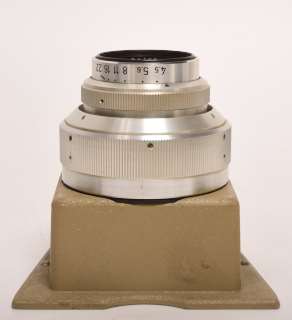
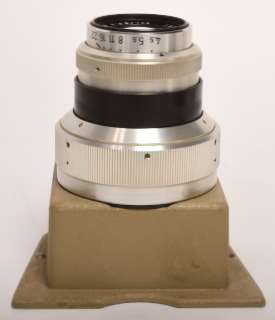
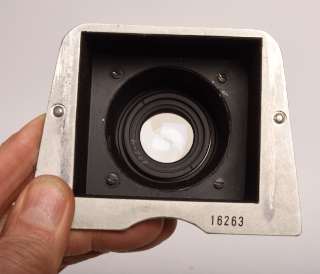
105mm F8 Fujinon SW, multicoated, Copal 0, covers an 11" image circle, covers 4X10", perfect glass, marks but no dents on barrel, hard to find lens, $700. The 8X10" Kodak Master view camera is a perfect choice for wide angle lens usage as short as 47mm. You will find the Kodak Master view camera on my View Camera web page. Add $80 for lens neatly mounted on a Sinar lens board. Yes, this Kodak Master view camera accepts Sinar lens boards. 77mm filter size. With both original lenscaps.
108mm F4.5 Wollensak Velostigmat series II, uncoated, Betax #2 shutter. Probably designed for a 6x9cm or 3 1/4 X 4 1/4" camera. Shutter working but sluggish. Glass is fairly clean. With cable release socket. No flange. $30
127mm F4.5 Tominon: see my Copy Cameras web page.
105-150mm F4.5 vari focal Computar DL, coated, barrel, Leica screw mount, will cover 4X5 @ 150mm but not @ 105mm, good for changing image size w/o changing enlarger height, fast and convenient, also good for special effects, may zoom while printing, consider combining this lens with my 2X3 baby Graflex SLR (listed on my view camera list along with a lensboard with Leica screw mount flange) as a zoom macro lens, Mint, $250

135mm F4.5 Tominon: see my Copy Cameras web page.
135mm f5.6 Componon, coated, Synchro Copal, flat field macro lens also good for infinity use, Mint, $300 Note: Check out Ken Kay's article on why he uses Componons for studio photography in "The Photography Catalog," designed after the "The Whole Earth Catalog," but devoted to the subject of photography. You may also use this as an enlarging lens.
150mm F9 G-Claron, coated, barrel, will cover 5X7, speck of dust between front elements, Mint-, $175

You may wonder how I test lenses to determine coverage. I use a larger format camera than the lens was intended to cover. I have several cameras set up to accept lenses with little effort. In this case, I used an 11X14 F&S. The clear circles on the camera back allow me to see the lens diaphragm and to focus on the aerial image--which is much brighter and sharper than the ground glass image. The 11X14 F&S easily allows me to focus with a lens as short as and even shorter than this 158mm. The 11X14 F&S is mounted on a Saltzman Studio Stand. Note that the large tripod top plate supports the hinged joint in the fold down rail. The 11X14 F&S is listed on my View Camera web page and the Saltzman Studio Stand is listed on my Tripod and view camera accessories web page. Also note the universal diaphragm lensholder that allows me to quickly mount lenses; universal diaphragm lensholders are listed on my Tripod and view camera accessories web page. When I have larger cameras in stock, I will test lenses with more coverage on larger cameras. I have an 8X20 Sinar that I also use to test lenses. And presently I have a 12X20 Sinar camera in stock, so I used it to test the ~300mm ~F8 lens listed below. See my Sinar page to see these cameras.
165mm F9 Computar, coated, in barrel with filter slot. This is a 210mm F9 Computar front element and barrel with a 150mm F9 Computar rear element. There is 1mm separation around the perimeter of the rear element; this will not affect the lens' performance because you will be using this lens stopped down for coverage. The diaphragm stops down to F90; diaphragm will give a little overexposure for this 165mm focal length. This lens has the same high quality definition as provided by a factory original Computar. It covers 8X10 and will outperform a 165mm (6 1/2") Wide Angle Golden Dagor. Clean glass. $OLD. This lens and the next lens are separated from the other lenses because they are both similar. You may want to buy both lenses. If you bought both lenses, you could combine the 2 front elements into one 210mm lens and the 2 rear elements into one 150mm lens. The Computar lenses are only similar to the Dagor. The Dagor is a symmetrical lens; the Computar is not symmetrical. By combining the 2 front elements and the 2 rear elements from these 2 lenses, you would have 2 symmetrical lenses that would be even more similar to a Dagor. My guess is that the two 210mm front elements will cover at least as much, be at least as fast and perform at least as well as the factory designed 210mm Computar. I may do this myself--except that I have 2 factory original 210mm Computars and I have far more projects lined up than I have time to complete.
These 2 165mm lenses $OLD. I leave this information up for your information. I do not want to see anyone taken advantage of by someone selling you a 165mm lens as a 210mm lens. I was not hurt because the 165mm lenses have value themselves.
165mm F9 Computar, coated, in barrel with filter slot. This is a 210mm F9 Computar front element and barrel with a 150mm F9 Computar rear element. There are some extremely slight cleaning scratches on the both the front and the rear lens groups. The diaphragm stops down to F90; diaphragm will probably give a little overexposure for this 165mm focal length. This lens covers 8X10 and will outperform a 165mm (6 1/2") Wide Angle Golden Dagor. $OLD Note: It is not all that unusual to find these lenses in this configuration. The 210mm Computar is a highly sought afer lens; crooks will take advantage of such a market. The 1st one I bought from a camera dealer who took short term advantage of my trust to sell me one of these lenses as a 210mm lens. His trick was short sighted because I later found out the truth and now I know better than to trust him. The other lens I bought off of Ebay; the seller sent me a partial refund when I told him about the situation. The rear elements of 150mm and 210mm Computar lenses are interchangable. The rear elements are oftentimes damaged. Here is what to look for: The diameter of the rear element glass differs between the 150mm Computar and the 210mm Computar.
180mm F4.5 Xenar, coated, barrel with diaphragm. Beautiful glass. Chrome plated brass barrel. Many bladed diaphragm. No flange. $120. This came in along with a 210mm Xenar lens and a Beattie Portronic camera. I have parts for this camera on my VIEW CAMERAS web page. Those parts are at no charge if purchased along with both Xenars.

210mm F4.5 Xenar, coated, barrel with diaphragm. Beautiful glass. Chrome plated brass barrel. Many bladed diaphragm. $180. This came in with an 180mm Xenar lens and a Beattie Portronic camera. I have parts for this camera on my VIEW CAMERAS web page. Those parts are at no charge if purchased along with both Xenars.

210mm F9 Computar lens. This is my favorite lens for the 8X10 format. The focal length is just right much of the time. It is small and compact compared to its competition, yet it will cover 11X14 at smallest aperture. This is an excellent performing lens. There are no scratches on the glass. I think the lens rear element has been recemented. The cemented layer has some bubbles in the cement. The person who sold me the lens did not tell me that. I have come to that conclusion from close and frequent inspection of the lens because everyone who has inquired about the lens wants to know about the imperfections. I have not had any luck illustrating the imperfections. The imperfections only are visible with a high power scope. The imperfections are taken into account in the price. The lens is very sharp and the excellent performance of the lens is also taken into account. The shutter is the original shutter with F-stop scales for both focal lengths that are not worn off as is often the case. The lens shade is original. There is a jamb nut. The lens caps are not original. There is a spacer ring between the rear element and the shutter. Spacer rings are almost always supplied with the lens by the manufacturer (because it is needed to optimize the performance) and they are therefore a good sign. Having the original shutter also supplied by the manufacturer is a good sign. Were the lens mounted in a shutter not supplied by the manufacturer and there were no spacer ring, it would probably be a barrel mounted lens that someone put into a shutter. The negative and positive images of the lighthouse were made with this lens on 11X14 film. The lens comes with a money back guarantee. Buy it, test it, keep it or return it for a refund. Even if a lens looks perfect, you would want to test it. I have tested it--on 11X14 no less! Who else does that? RARE, $OLD. This lens was sold along with a custom filter adapter a month or so ago. I have already heard from the buyer that he is satisfied with the lens. I leave this listing up for your information. Everyone prefers pristine lenses, but they cannot always be found. This lens was on the market for several years. During that time, I did not see another such lens come onto the market. People who have these lenses rarely part with them.




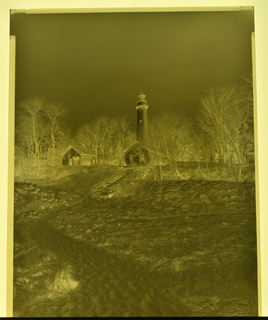

Lens shade for 210mm F9 Computar. A most unusual lens shade; note the threads inside and out. This lens shade fits several Computar lenses of various focal lengths from 150mm up to 360mm. Outside diameter threads are 49mm. $60.
GLENNVIEW filter adapter for 210mm F9 Computar. With only outside 45mm threads, Computar lenses are not well designed to accept filters. Most of us working with these lenses are shooting B&W film and we like to use filters. I made a couple of filter adapters. Presently they have rear threads to mount onto the lens. On the front side I can cut threads from 49mm to 58mm. 49mm threads + filter (or no threads) would vignette a little, so I do not recommend them. 52mm or larger threads will not vignette even with a filter attached. A 67mm adapter ring fits over the adapter with a snug fit, but for the sake of safety, I suggest you have me epoxy on the 67mm adapter. Basic price of the aluminum adapter is $150. Add $50 for front threads of your choice. Add $50 for 67mm adapter epoxied to aluminum adapter. I have one or 2 more filter adapters made up that I will be listing when I find the time.
4 GLENNVIEW adater lensboards + Sinar Norma lensboard. As long as you are seeing the computar lens mounted as shown above, I might as well offer you the set of 4 adapter lensboards (3 with #1 hole size and 1 with #3 hole size). $400
Lens barrel with diaphragm (to F90), gel filter holder, and flange for 210mm F9 Computar. $175.
240mm F6.8 IMAGONAL SATZ II or Imagonal lens set 2. Uncoated, barrel mount with diaphrapm. Front element screws into barrel. Rear elements bayonet into barrel. You may use any of the rear elements in combination with the front element or by themselves. The front element may be used by itself. The focal lengths are: 175, 200, 240, 300, 330, 360, 420 and 650mm. The name "imagon" is associated with the more modern soft focus imagon. I do not know if this is a soft focus lens; I would guess not. My best guess is that it is more like a Dagor type double anastigmat lens. The lens barrel itself bayonets into the lens flange. There is no lens flange. I will make a flange for the lens when I find the time or the need. The lens glass is very clean. There is no separation. There are no scratches. There is some paint coming off of the lens edges. There are 2 somewhat faded light to medium yellow filters. The lens, the filter rings and screw on front ID ring are not dented. It is in the original lens case with the original information sheet. The information sheet for the II was not yet ready, so the information sheet for the Imagonal set I was used and portions overwritten. RARE! $500 as is or $800 with a custom made flange. This lens is quite usable in addition to being collectable. it is even possible to mount it into a #3 shutter. All focal lengths will cover 4X5 and 5X7; 240mm and longer focal lengths will cover 8X10. Longer focal lengths will cover even larger formats.


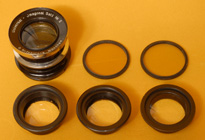
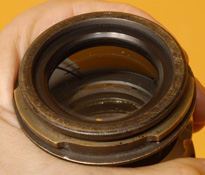


~292mm (11 1/2") F4 Wollensak Verito diffused focus lens accessories only. The lens was sold in a barrel. Still available is all else--including a flange for the lens, the shutter, the Verito to shutter adapter, series 9 lens shade, filters, Deardorff lens board. These items are listed in detail on other pages. The shutter, the lens adapter and the flange are listed on my VIEW CAMERA LENS ACCESSORIES web page. The lens board is listed on my VIEW CAMERAS web page. The filters, lens shade and filter retainers are listed on my FILTERS, LENS SHADES, ADAPTERS, etc. web page.
300mm f5.6 Symmar-S, coated, Copal #3 shutter, Mint-, $500. For those looking for a #3 shutter to fit a lens that is too big for an ordinary Copal #3 shutter, this has 3mm larger diameter threads than either a standard Copal #3 or #3S shutter. The thread size is 58mm X .75mmp.
300mm f5.6 Componon, coated, NEW Copal 3 shutter, Mint-, $550
300mm F7.7 Dallmeyer Dallon, coated, PC-synched dial set Compur, compact telephoto, rear element is 43mm diameter, front element is 49mm diameter, overall length is 73mm, will fit onto small lensboards and fit through small openings and it is just what is required for such cameras with short bellows as telephoto lenses require less extension than non-telephoto lenses, covers 5X7+, this lens is fairly sharp--not as sharp as but much smaller and lighter than Schneider and Rodenstock telephotos (illustrated below beside Schneider 270mm Tele Arton), shutter has been newly cleaned, lubed and adjusted. The front element group was badly cemented. Not enough cement was used. It is not coming uncemented; it wasn't sufficiently cemented initially. I have seen several other 300mm Dallons like this. Put a liquid between 2 pieces of glass and see what you get; the photo below is what you may get. It was difficult to photograph in order to show it at its worst, but there you have it--shown much worse than it really is. The cemented layer is transparent when viewed straight through, but uneven when viewed obliquely. Photos made with lens at F22. $250
300mm f9 Apo Nikkor, coated, barrel, filter slot, some slight cleaning scratches will in no way affect the lens' performance, no flange, Ex, $100
305mm F5.6 American Optical Co. Type 1, coated, complete with yellow and red center filters, front and rear lenscaps, very wide angle, looks like a Hypergon w/o the fan, but it has more elements and is a higher quality lens, covers 12X20 with movements! Designed as a high resolution mapping and spy lens for use in planes like the U2, it is sharp and rectilinear, but decidedly soft focus @ F5.6. It's a true soft focus, too, similar to the Kodak Portrait lens in performance with spherical abberation the source of the softness which means that the abberation is at the lens' periphery. It gradually, but rather quickly becomes sharp as you stop down. At f8, 3/4 of the soft focus effect is gone. At F11, almost all of the soft focus effect is gone. The center filters in that huge size would cost about $2000 each today. Center filters help even out the exposure on extreme wide angle lenses, however I have not noticed any light falloff in the 8X20 format w/o the center filters. Lens in barrel with water house stop set from F5.6 to F90, + 2 soft focus stop sets (similar to Imagon stop sets), + 4 blank stops, with manual slide shutter. This lens in this configuration has been sold, but I can build another, New-old-stock, $1800, filters slightly less than mint. Also available in barrel with F45 fixed aperture mounted on Sinar lensboard @ $1200--illustrated following the filters. Will custom mount to lensboard for your camera. Due to the design of the lens, it is not possible to mount the lens into a modern shutter. I was able to mount the lens on either side of a Sinar shutter for one customer. Also due to the design, it is virtually necessary to incorporate the lensboard into the barrel as illustrated.
305mm f9 Apo Nikkor, coated, barrel, filter slot, Mint-, $200
305mm F9 Carl Meyer Apo-Process lens, coated, Synchro Alphax shutter, numerous scratches on glass, but a great performer nevertheless, covers 11X14", outperforms most other 12" lenses by my experience, from my personal user inventory, $400. Carl Meyer is one of Burke and James' house brands. Burke and James did not actually manufacture lenses. Instead, Burke and James remanufactured other manufacturer's lenses. This lens was originally an Apo-Process lens made most likely by Goerz. The serial numbering system is Kodak's which means that this lens was remanufactured by Burke and James in 1969. Comes with 2 metal lenscaps.
305mm F9 Rodenstock Apo-Copygon, coated, barrel, Mint, $200
prism from 330mm F10 Wollensak Apochromatic Raptar, may be used on another lens with a front barrel outside diameter of 47.78mm or 1.181" or slightly less, Mint, $20
360mm F9 Apo Nikkor, coated, barrel, lens has filter slot that accepts gel filter holders, includes several gel filter holders, customizable stop set, round diaphragm, and square diaphragm, boxed, except for a couple of slight cleaning wisps, Mint-, $450. Not only do you have a square diaphragm in addition to the round diaphragm, but you may rotate that square diaphragms with a calibrated rotation scale. From rear of lens: round diaphragm scale calibrated in 1/3 F-stops, filter slot rotating cover, square diaphragm scale, square diaphragm rotating scale calibrated in 5 degree increments. The advantages of the rotating square diaphragm: 1) elimination of image degrading non image forming light, 2) formation of square or, if rotated, diamond shaped dots in your printing plate. In some situations in ordinary photography where you may see the shape of the diaphragm in the form of flare--you could have a square or diamond shaped flare artifact instead. The blank stops may be cut to any shape diaphragm opening you want.
405mm F4.5 Kodak Portrait lens, coated, barrel. This lens is not available, but it is quite rare and I publish it for your information. It is properly mounted on a Deardorff 8X8" lensboard which is mounted in a Deardorff 11X11" recessed lensboard with a rear mounted synchronized Packard shutter for use on a Deardorff 11X14 camera. A customer asked me to build him a "point & shoot" camera for use with this lens. I told him a point & shoot camera was not possible because it is necessary to focus this lens. The 8X10" camera I built is shown mounted upon a Houston Fearless tripod. The tripod is available. You will find it at the top of my TRIPODS web page. The customer I built the portrait camera for said "Hi Glenn, The camera is Exquisite. Quite frankly I was not surprised when I saw each component because you do nothing but flawless work. You have created my best pieces in my entire 47 year photographic life."
Prism for use with lens ~66mm outside front barrel diameter maximum, came in with 15" (382mm) Apo Raptar, with mount, Mint optics, Ex+ exterior, $20
Prism for use with lens ~63mm outside front barrel diameter maximum, Ex, $20
480mm F9 Rodenstock Apo Ronar, coated, barrel, stops down to F260, also with millimeter scale, filter slot, 1/4" scratch front element, otherwise fine, $200
480mm F9 Rodenstock Apo Ronar CL, coated, barrel, stops down to F90, also with millimeter scale, auto closing filter slot, with lens shade and front leather lens cap for shade, with rear lens cap. The Apo Ronar CL is Rodenstock's best Apochromatic lens. The Apo Ronar CL is recommended for map making and other situations that call for higher resolution. Mint, $400. This came in without a flange. So I can supply a flange from another lens with the Apo Ronar CL for an additional $125. The lens shade fits perfectly in the same manner as it was designed to fit onto a 420mm or 480mm Apo Nikkor. The lens shade with lens cap have been $OLD and the price of the lens was reduced.
The paragraph below is copied from a 1951 C. P. Goerz American Optical Company catalog.

And, quoting from a 1919 Wollensak catalog, "Air bubbles are not, as is often thought, a defect in photographic lenses. In fact, while they are more apparent in the highest type of lens, they seldom appear in the cheaper grades. Bubbles are caused by the necessity of fusing the optical glass used in making lenses of high quality at a certain temperature, whether all bubbles have risen to the surface or not, in order to maintain certain optical properties. Such bubbles absolutely do not impair the definition or lessen the efficiency of a lens in the slightest degree."
How to clean your lenses. Virtually all lenses will pick up a film over time. Our atmosphere is far from pristine. Any lens shipped via diesel trucks, jet fueled planes, etc. will likely pick up a film. It is not good to clean lenses any more than necessary. In case you do not know how to clean lenses: 1st make sure any dirt or debris that could scratch the lens is not on either the lens or the tissue. Inspect the lens surface for dirt by looking at it with light reflected off of its surface as well as through it. Do not hesitate to inspect with a magnifying lens. Put the lens cleaning fluid onto some tissue, not on the lens. If you put the cleaning fluid onto the lens or if you use excessive fluid, the fluid may work its way down around the edges of the lens and may affect the cemented layer. Start in the middle and work your way out to the edges. Rub lightly at 1st feeling for any dirt you may have missed. Do not grind dirt into the lens; you will likely scratch it. After cleaning the lens, use a 2nd piece of fresh tissue to pick up a little moisture still left on the lens and finish the job; you want a little moisture on the tissue to act as a lubricant. Denatured alcohol is a good lens cleaner if commercial photographic lens cleaning solutions are not available. Oftentimes, either will not clean some films off of lenses. I have found that one's breath does a good job of cleaning such stubborn films off of lenses and have used this technique for decades without problems. I have read that one's breath is not good for lenses according to one manufacturer of lens cleaning solution, but then that manufacturer's business is selling cleaning solution. I will continue to use my breath only when lens cleaning solution does not do the job. Recently I was cleaning some tele-extenders that had some small spots on them that may have been tree sap. Neither alcohol nor my breath would remove those spots, but the lens cleaner illustrated below did. Acetone can be used as a lens cleaner for some substances, but be aware that it will soften paint and maybe some plastics, so best to use it on a Q-tip only to remove stubborn spots on the lens surface away from the barrel. Do not use your shirt or whatever is available to clean your lenses. Use only high quality lens cleaning tissue. Kodak is a good brand if still available. I use some vintage tissue from the American Optical Company. Center filters may have something like a silver coating on them which may scratch and/or oxidize easily. Be especially careful with older lenses. Some very old lenses are quite resistant to scratches; other older lenses are particularly prone to being scratched, a prime example being Kodak Commercial Ektar lenses and other lenses of about the same vintage. That is why you will rarely find a perfect Commercial Ektar. I am suspect of some lenses that do not have scratches because they may have been reworked. I had a particularly bad experience with Pacific Optical Company, who made some lenses look beautiful, but the lenses no longer performed well. Virtually no one is competent to rework lenses today. I would prefer a factory original lens with scratches to a reworked lens any day. Only the original factories had the skilled workers with the specifications, the knowledge, the experience and the equipment to do the job correctly. In the past there were some remanufacturing facilities that did a competent job. Burke & James was one. When B&J reworked a lens, they changed the lens' name to Carl Meyer or Karl Meyer. You have to guess what the lens originally was by other clues. I have a couple of 12" lenses reworked by B&J on this list. They have both been tested and perform exceptionally well and are reasonably priced. Just as American Optical Company said about air bubbles, "......the presence of a few air bubbles does not in any way affect the work of the lens. Their presense is rather a guarantee of quality than otherwise." .....scratches may also be an indication of original factory quality.